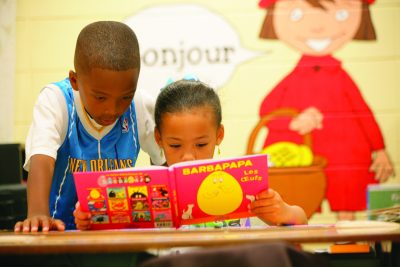Winter 2017
The Rising Marée that Lifts All Bateaux
French immersion schools fuel bilingual economy
Published: December 8, 2017
Last Updated: August 21, 2023

Almost 5,000 students now participate in French immersion schools in Louisiana.
With the passing of each Louisiana Francophone, we risk further erosion of our identity, not to mention that identity’s influence on our state’s internationally recognized brand. From a humanitarian standpoint, this loss is nothing less than tragic; from an economic standpoint, it is inexcusable. Each day that passes without real linkage of our living French culture to the global market, we lose more of our competitive advantage where our own sense of place makes less and less sense. The coastal erosion metaphor is apropos here not only for its parallels with an endangered culture and the risks associated with inaction but also because of its strong sense of urgency. Just as our coastal marshes are deprived of the rich alluvial deposits unfortunately channeled far out into the gulf, Louisiana’s deeply rooted authentic culture risks losing the replenishing nutrients that could spur new growth and stability, first in the cultural industry and beyond. Far from the banks of the “mainstream,” without economic applications, both the culture and its language could go under.
That cultural levee was breached in 1921 when the state Constitution banned the speaking of French in the public schools. Many in Louisiana still recall as children the humiliation of having to write the infamous lines “I will not speak French on the school grounds.” While the economic benefits of speaking English were evident to all, especially with the advent of the oil and gas industry, it was not until the creation of CODOFIL in 1968 that we would begin efforts to develop a linguistic identity that could actually add value to the local economy. Later on, in the ’80s, when the bottom fell out of the energy industry and economic diversification became the new mantra, “Cajun is hot” was breaking all heat records; yet absent from that trend were any strategies for developing a bilingual workforce to sustain this new model for the cultural economy.
How quickly and to what extent are Cajun, Creole, and Native-American Francophones disappearing? One kitchenful every ten minutes? One dancehall’s worth every forty-eight hours?
Fast-forward to today’s Louisiana public school system, with its thirty-two programs of French Immersion in which almost five thousand students are functionally bilingual. Louisiana remains blessed with many living cultural assets that may jumpstart the careers of these students. Cultural economic erosion may be controlled by developing educational programs where students can be trained as workers and entrepreneurs in the business of culture, with the Louisiana French language as platform. Never has the timing been better for Louisiana to launch an amazing era of prosperity by turning out workers who will produce new products driven by creativity and innovation, inspired by culture and heritage. And by showcasing these products and services, an increase in demand from a highly motivated international francophone niche market should promote new cultural business ventures, which would directly impact both the economy and cultural preservation.
From school, finally, to work, our heritage language will have come a long way. Though Louisiana’s culture may be naturally weathered and worn, any future erosion may be reduced by empowering communities to come out of “detention” and embrace a more mindful approach: “I will not leave French on the school grounds!”
—
Charles Larroque is Directeur executive of CODOFIL.

